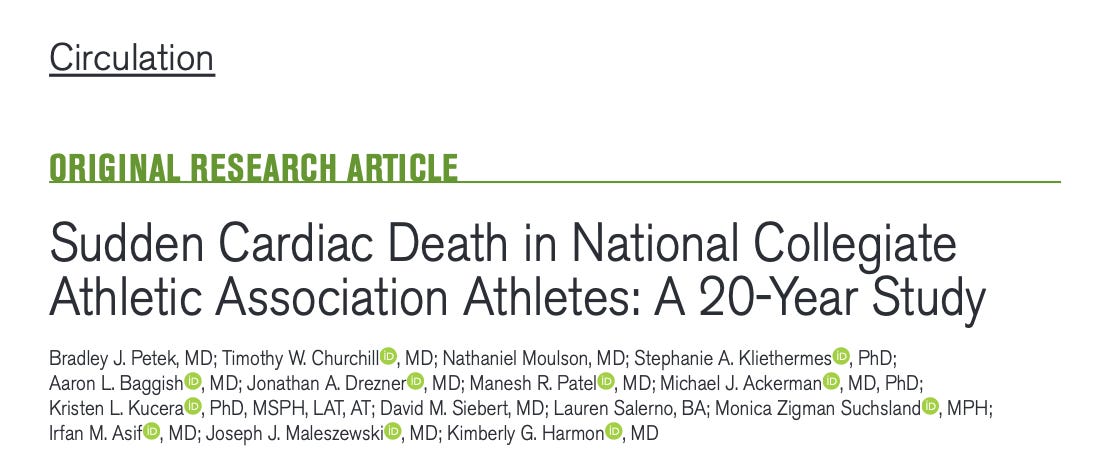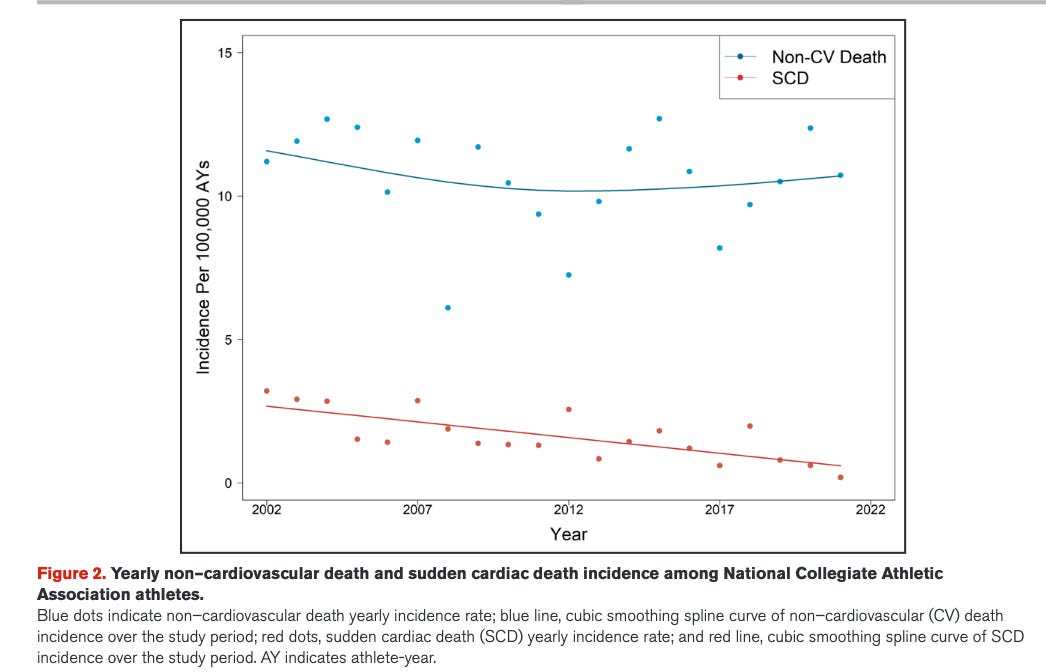The NCAA study of sudden cardiac death (SCD) findings as expected & can't answer all of our questions about covid vax risk of SCD
I am being asked to comment on a recent study in Circulation by Petek et al.
This study found a decreasing rate of sudden cardiac death over time among participating NCAA college athletes (red line). Despite the appearance of the graph, the study goes through June of 2022. It’s a 20-year study but, the yearly population is not that huge (I’ll get to that).
A lot of people are using this to say it somehow proves the COVID-19 vaccines didn’t come with an increased risk of cardiac death, but there are a number of things to keep in mind that might mean this study is not able to fully determine that.
First, what is the denominator here? It is strange the authors don’t state how many athletes they are including per year stratified by sex and sport; those pieces of information are critical to a sports epidemiology analysis like this. There are fewer athletes in the NCAA on a yearly basis than people may think (currently about 500,000). This limits the power of the study in terms of assessing vaccine-associated cardiac deaths (particularly if just looking at the male sex) considering how rare these types of deaths (thankfully) appear to be according to studies of databases including millions of vaccinated people.
The total population of athletes per year, per a quick NCAA search appears to be about 520,000, almost 300,000 of which are male. Now let’s say all of these males are included in the study in June 2021-June 2022. Let’s say 85% got mRNA vaccines. This leaves a population of around 255,000, assuming they are all included (I can’t see the study says # of included athletes by year). The best studies we have put the risk of mRNA vaccination related cardiac death rates in young adults males at somewhere between 1 to 3/million primary series given (Korea,Qatar, UK). Even the highly-controversial Florida study (which I was not a co-author of for the 100th time :)) had excess cardiac deaths post 2nd dose mRNA vax estimated in the single digits (I calculated 9) among males 18-39 (the “84% increase” caused a lot of confusion), which there are about 3 million of in Florida, though not all got mRNA so the Florida estimate is a little higher than 3/million but not totally dissimilar. I wrote about this on Sensible Medicine. But let’s focus on the studies from Korea, Qatar and the UK: if we are saying the mRNA vaccines appear to cause an excess of 3 deaths/million vaccinated college-aged males, how many extra cardiac deaths would we expect to see in 2021-2022 or during the first year of vaccination in the NCAA? The answer is 0-1! So we could not detect an increase on the order of 1 to 3/million this in a population of only 255,000 or even 300,000! So the study is underpowered to disprove what UK, Qatari and Korean studies have suggested.
There is more. Women are at around 1/4 of the risk of males for sudden cardiac death. I’m getting this directly from the Petek et al paper. Women’s participation in NCAA sports is also percentage-wise increasing each year. I did not get this from the paper, but from the NCAA statistics. It would have been great if the authors had mentioned or shown data for this. What the increase % wise in female athletes over time means that SCD risk is expected to decrease year by year as the % women athletes increases. This is basic math.
There is still more. Different sports seem to have different risks of SCD. The authors are very smart to focus on basketball stats. Basketball, according to their study, is the highest risk sport for SCD.
Now THIS (basketball’s SCD risk) importantly, has not changed over time. The authors state the incidence among black and white male basketball players “remains high” (and importantly has not had its intrinsic risk watered down over time by changing demographics like the overall study has).Participation in men’s basketball has not increased over the last few years the way participation in lower risk sports like women’s track and field, women’s volleyball, and men’s soccer have. Relative increases over time in lower risk sports in NCAA will also cause the incidence of SCD to decrease over time.
So the entire supposed “decreased risk” we seem to see over the 20 years through the first half of 2022 is actually more likely to be due to decreased incidence in a population with decreasing in risk each year related to higher participation in lower risk sports/higher % female population (more females, basketball not growing at the same rate as other sports). This is not to say cardiac care of athletes has not improved in the last 20 years. I just think much if not most of the change we are seeing over time can be explained by the changing athlete demographics to being lower risk for SCD.
Bottom lines:
-This study population is too small to detect the types of cardiac death risks we suspect could be due to mRNA vaccines (looking at the best studies)
-The decrease in incidence in SCD over time (red line is expected given the change in the athlete population over time (more females, higher % of lower SCD risk sports participation in NCAA)
-Disturbingly, we don’t have a reason for the (small) increase in non-CV deaths (blue line in above figure). I’m not saying it is the vaccines. I am just saying we don’t know. But I wish they would have shown the trends by year and not just overall rate for the 20 year study
Another post to read
I wrote my substack post as a supplement to John Mandrola’s substack on the same topic. He started out his post by saying (and I love this) he is curious what everyone else thinks. He gave his much-appreciated cardiologist take and now here is my epidemiologist/sports medicine doc take.
In the spirit of debate, something specific I want to comment on that he wrote is “this study again confirms anecdotes don’t always sum to evidence”
I guess it depends on which types of anecdotes. If we are talking the autopsy confirmed myocarditis deaths attributed to the vaccine documented in Korea and Germany, then I disagree. Just because something is rare, doesn’t mean it is not happening; that is when and why anecdotes are important. They can alert us to the existence of a condition/outcome or suggest an increase in a very rare occurrence. And this study is too small to rule out increases in cardiac death on the order of 3/million.
But I do agree with John, it is beyond foolish the way some people seem to be attributing every sudden death in athletes to the vaccines. It’s unprofessional, unethical and misguided. This study certainly does rule out a massive epidemic of sudden cardiac deaths in athletes due to either COVID or the vaccines. But when people were coerced or mandated to take a vaccine for a disease that is very low risk to them - and add to that on the false premise it will protect others - even one death total is too many and 3/million is way too many.
I hope the study authors or anyone else will comment if they feel I have made any errors of missed anything important. I would also love to know what the total yearly population of this study was - I apologize if I have missed it!








